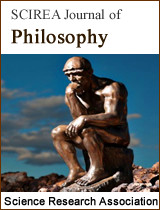The Reducibility of Generalized Modal Syllogisms Based on ☐AM◊I-1
DOI: 10.54647/philosophy720075 81 Downloads 94008 Views
Author(s)
Abstract
There is the reducibility between the generalized modal syllogism ☐AM◊I-1 and the other 20 valid generalized modal syllogisms. This paper first proves the validity of the generalized modal syllogism based on the truth value definitions of sentences with quantification, set theory and modal logic, then derives the other 20 valid generalized modal syllogisms from the syllogism ☐AM◊I-1 in line with some facts and inference rules. The reason why these syllogisms are reducible is that: (1) any of the Aristotelian quantifiers can be defined by the other three Aristotelian quantifiers; (2) any of the four generalized quantifiers in this paper (that is, most, at most half of the, fewer than half of the and at least half of the) can be defined by the other three generalized quantifiers; (3) the Aristotelian quantifiers some and no have symmetry; (4) a necessary modality ☐ and a possible modality ◊ can be mutually defined. And the process of these reductions are ultimately presented in a structured formalization way. Thus, this paper provides a fragmentary research approach for other generalized modal syllogisms including four generalized quantifiers with transformation relations. There are many generalized modal syllogisms in natural language. Therefore, this study has practical significance and theoretical value for knowledge representation and reasoning in artificial intelligence.
Keywords
Generalized modal syllogism; Reducibility; Generalized quantifier; Validity
Cite this paper
Jing Xu, Xiaojun Zhang,
The Reducibility of Generalized Modal Syllogisms Based on ☐AM◊I-1
, SCIREA Journal of Philosophy.
Volume 3, Issue 1, February 2023 | PP. 1-11.
10.54647/philosophy720075
References
| [ 1 ] | Hui, L., Reduction between categorical syllogisms based on the syllogism EIO-2, Applied Science and Innovative Research, 7, 2023, pp. 30-37. |
| [ 2 ] | Johnson, F., Aristotle’s modal syllogisms, Handbook of the History of Logic, I, 2004, pp. 247-338. |
| [ 3 ] | Murinová, P. & Novák, V., A Formal Theory of Generalized Intermediate Syllogisms, Fuzzy Sets and Systems, 186, 2012, pp. 47-80. |
| [ 4 ] | Endrullis, J. & Moss, L. S., Syllogistic logic with ‘Most’, in V. de Paiva et al. (eds. ), Logic, Language, Information, and Computation, 2015, pp. 124-139. |
| [ 5 ] | Łukasiewicz, J., Aristotle’s Syllogistic: From the Standpoint of Modern Formal Logic, second edition, Oxford: Clerndon Press, 1957. |
| [ 6 ] | Long W., Formal System of Categorical Syllogistic Logic Based on the Syllogism AEE-4, Open Journal of Philosophy, 13(1), 2023, pp. 97-103. |
| [ 7 ] | Xiaojun Z., Reducible relations between/among Aristotelian modal syllogisms. SCIREA Journal of Computer, 5, 2020, pp.1-33. |
| [ 8 ] | Cheng, Z., How to Deduce the Other 91 Valid Aristotelian Modal Syllogisms from the Syllogism ☐I☐A☐I-3, Applied Science and Innovative Research, 7(1), 2023, pp.46-57. |
| [ 9 ] | Peters, S. and Westerståhl, D., Quantifiers in Language and Logic, Claredon Press, Oxford, 2006. |
| [ 10 ] | Halmos P. R., Naive Set Theory, New York: Springer-Verlag, 1974. |
| [ 11 ] | Chellas, F., Modal Logic: an Introduction, Cambridge: Cambridge University Press, 1980. |
| [ 12 ] | Cheng, Z, and Xiaojun Z., Reduction between Aristotelian Modal Syllogisms Based on the Aristotelian Modal Syllogism ◊I☐A◊I-3, Open Journal of Philosophy, 13(2), 2023. |
| [ 13 ] | Cheng, Z., The Remaining 23 Valid Aristotelian Syllogisms can be Deduced only from the Syllogism IAI-3, SCIREA Journal of Computer, 7(5), 2022, pp. 85-95. |
| [ 14 ] | Chagrov, F. and Zakharyaschev, M., Modal Logic, Oxford: Clarendon Press, 1997. |

